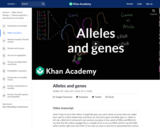
A gene as a stretch of DNA on a chromosome. Alleles as versions (sequence variants) of a gene.
- Subject:
- Biology
- Genetics
- Life Science
- Material Type:
- Lesson
- Provider:
- Khan Academy
- Provider Set:
- Khan Academy
- Author:
- Sal Khan
- Date Added:
- 12/10/2014

A gene as a stretch of DNA on a chromosome. Alleles as versions (sequence variants) of a gene.

This annotated slideshow adapted from KET's Electronic Field Trip to the Forest illustrates how blight decimated the American chestnut tree and the methods scientists use to identify and pollinate the remaining trees to create blight-resistant trees.
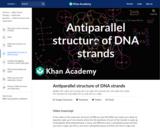
DNA is composed of two strands of nucleotides held together by hydrogen bonding. The strands each run from 5' to 3' and run in antiparallel, or opposite, directions from one another.

Binary fission, budding, mitosis, fragmentation, parthenogenesis and sexual reproduction.
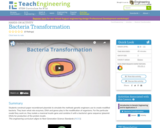
Students construct paper recombinant plasmids to simulate the methods genetic engineers use to create modified bacteria. They learn what role enzymes, DNA and genes play in the modification of organisms. For the particular model they work on, they isolate a mammal insulin gene and combine it with a bacteria's gene sequence (plasmid DNA) for production of the protein insulin.
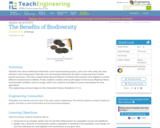
Students toss coins to determine what traits a set of mouse parents possess, such as fur color, body size, heat tolerance, and running speed. Then they use coin tossing to determine the traits a mouse pup born to these parents possesses. Then they compare these physical features to features that would be most adaptive in several different environmental conditions. Finally, students consider what would happen to the mouse offspring if those environmental conditions were to change: which mice would be most likely to survive and produce the next generation?

This 28-minute video lesson provides an introduction to DNA. [Biology playlist: Lesson 6 of 71].
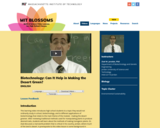
This learning video introduces high school students to a topic they would not ordinarily study in school, biotechnology, and to different applications of biotechnology that relate to the main theme of the module - making the desert greener. After reviewing traditional methods used for manipulating plants to produce desired traits, students will learn about the methods of making transgenic plants. Dr. Ziad discusses a real world problem that is critical in his country, Jordan, where much of the land is desert. A prerequisite to this video lesson is some background in biology.

Bug Hunt uses NetLogo software and simulates an insect population that is preyed on by birds. There are six speeds of bugs from slow to fast and the bird tries to catch as many insects as possible in a certain amount of time. Students are able to see the results graphed as the average insect speed over time, the current bug population and the number of insects caught. There are two variations to try for the predator, one where the predator pursues the prey and one where the predator stays still and captures insects that pass nearby. In the first case the bird catches the slow insects and the faster ones survive, reproduce and pass genes on. The average speed of bug should increase over time. In the second case the faster bugs come near to the bird more often than the slow ones. The slow ones survive more, reproduce and pass their genes on.

Submitted as part of the California Learning Resource Network (CLRN) Phase 3 Digital Textbook Initiative (CA DTI3), CK-12 Foundation’s high school Biology FlexBook covers cell biology, genetics, evolution, ecology, botany, zoology, and physiology. This digital textbook was reviewed for its alignment with California content standards.

CK-12’s Life Science delivers a full course of study in the life sciences for the middle school student, relating an understanding of the history, disciplines, tools, and modern techniques of science to the exploration of cell biology, molecular biology, genetics, evolution, prokaryotes, protists,fungi, plants, animals, invertebrates, vertebrates, human biology, and ecology. This digital textbook was reviewed for its alignment with California content standards.
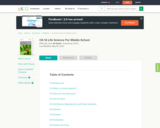
CK-12’s Life Science delivers a full course of study in the life sciences for the middle school student, relating an understanding of the history, disciplines, tools, and modern techniques of science to the exploration of cell biology, genetics, evolution, prokaryotes, protists, fungi, plants, the animal kingdom, the human body, and ecology. This digital textbook was reviewed for its alignment with California content standards.

An introduction to what cancer is and how it is the by-product of broken DNA replication.
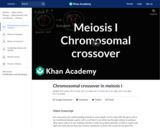
How homologous chromosomes exchange fragments in prophase I. Tetrads, chiasmata, and alleles.

This resource is intended for an introductory or intermediate-level college genetics course. It begins with an exploration of DNA and genome structure and continues with a study of the molecular mechanisms that drive gene expression. Concepts of classical transmission genetics are linked to the molecular mechanisms that underlie observable phenotypes. It concludes with specific topics that synthesize information from both molecular and transmission genetics, including consideration of topics like epigenetics, cancer biology, and evolution. Examples of both historical and current problems in genetics are presented, along with conversations of the relationship between genetics and society.

Overview of DNA transcription, translation, and replication during mitosis and meiosis. Learn about chromosomes, chromatids, and chromatin.
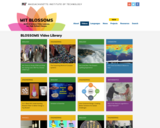
The topic of this video module is how to classify animals based on how closely related they are. The main learning objective is that students will learn how to make phylogenetic trees based on both physical characteristics and on DNA sequence. Students will also learn why the objective and quantitative nature of DNA sequencing is preferable when it come to classifying animals based on how closely related they are. Knowledge prerequisites to this lesson include that students have some understanding of what DNA is and that they have a familiarity with the base-pairing rules and with writing a DNA sequence.
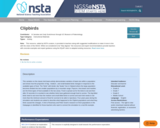
This variation on the classic bird beak activity demonstrates variation of beak size within a population and shows how the proportion of big-, medium-, and small-beaked birds changes in response to the available types of food. The birds with binder clip beaks live in Clipland where the large population becomes divided into two smaller populations by a mountain range. Popcorn, lima beans and marbles are the three types of food available in the two areas. Food is spread out for the birds to eat and then after 15 seconds it is counted to see whether birds have gathered enough food to survive. The big billed birds need to eat more than the medium and small billed birds to survive and each bird needs to eat more than the minimum amount of food for survival to be able to reproduce. Four years pass during the simulation and students are asked to describe what happened to the Clipbird populations and what they think caused the changes. A link to Rosemary and Peter Grants research on finch populations in the Galapagos is identified for those teachers who want to connect the simulation to a real life example.
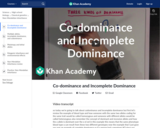
In complete dominance, only one allele in the genotype is seen in the phenotype. In codominance, both alleles in the genotype are seen in the phenotype. In incomplete dominance, a mixture of the alleles in the genotype is seen in the phenotype.
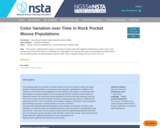
This activity provides an introduction to natural selection and the role of genetic variation by asking students to analyze illustrations of rock pocket mouse populations (dark/light fur) on different color substrates in the Sonoran Desert (light/dark) over time. Based on this evidence, and what they learn about variation and natural selection in the accompanying short film, students use this evidence to explain the change in the rock pocket mouse populations on the lava flow (dark substrate) over time. This is one of several classroom activities, focusing on related topics and varying in complexity, built around the short film. This ten minute film shows adaptive changes in rock pocket mouse populations, demonstrating the process of natural selection and can be accessed at http://www.hhmi.org/biointeractive/making-fittest-natural-selection-and-adaptation. The film is also available as an interactive video with embedded questions, which test students understanding as they watch the film.